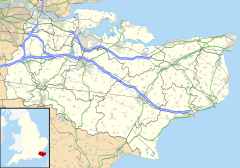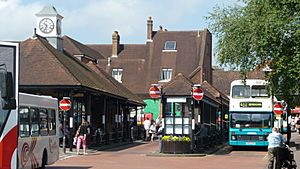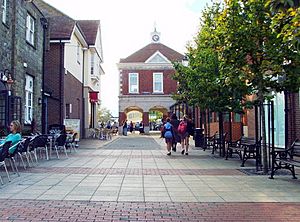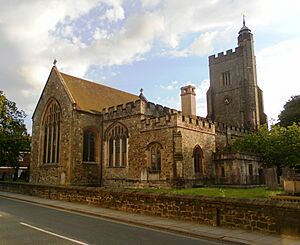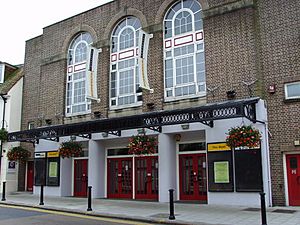Sevenoaks facts for kids
Quick facts for kids Sevenoaks |
|
|---|---|
| Town | |
 Knole House |
|
Coat of Arms of Sevenoaks Town Council Motto: Floreant Septem Quercus May the seven oaks flourish. |
|
| Population | 29,506 20,409 (2011 Census) |
| Demonym | Sennockian |
| OS grid reference | TQ525555 |
| Civil parish |
|
| District | |
| Shire county | |
| Region | |
| Country | England |
| Sovereign state | United Kingdom |
| Post town | Sevenoaks |
| Postcode district | TN13, TN14, TN15 |
| Dialling code | 01732 |
| Police | Kent |
| Fire | Kent |
| Ambulance | South East Coast |
| EU Parliament | South East England |
| UK Parliament |
|
Sevenoaks is a town in Kent, England. It is located south-east of London. About 29,506 people live here. Sevenoaks is also a civil parish, which is a local government area.
The town has a main railway line that connects it to London. It is about 21 miles (34 km) from Charing Cross, a central point in London. Sevenoaks is the biggest town in the Sevenoaks district. Other towns nearby include Swanley and Edenbridge.
Sevenoaks was first recorded as a settlement in the 1200s. A market was started then. The building of Knole House in the 1400s helped the village grow. In the 1700s, a turnpike (a road where you pay to use it) opened, connecting Sevenoaks to other places. The railway arrived later. Today, many people who live in Sevenoaks travel to London for work. This means it is a commuter town.
Knole Park is a large park located south-east of the town. Knole House is inside this park. Schools in Sevenoaks include Trinity School, Knole Academy, and the private Sevenoaks School.
Contents
- What's in a Name? The Story of Sevenoaks
- A Look Back: History of Sevenoaks
- Staying Healthy: Healthcare in Sevenoaks
- How Sevenoaks is Run: Governance
- Where is Sevenoaks? Geography
- People and Population: Demography
- How Sevenoaks Works: Economy
- Famous Places: Landmarks
- Places of Worship: Religious Sites
- Learning in Sevenoaks: Education
- Getting Around: Transport
- Fun Things to Do: Leisure
- Sports in Sevenoaks
- Arts and Entertainment: Culture
- News and Media: Local Media
- Famous Faces: Notable People
- Friends Around the World: Twinnings
- See also
What's in a Name? The Story of Sevenoaks
In the year 1100, the town's name was written as Seouenaca. This name comes from two old English words: seofon (meaning seven) and ac (meaning oak). So, Sevenoaks means "the place of the seven oaks."
The original seven oak trees were in Knole Park. They have been replaced many times over the years. Some people also believe the name might come from "Chevenix," but this is less common.
A Look Back: History of Sevenoaks
We don't have many records about Sevenoaks before the 1200s. That's when the town was given permission to hold a market. A weekly market for cattle was held in Hitchen Hatch Lane until 1999. Now, a food market takes place in the town centre every Saturday.
In the Middle Ages, religious groups set up two hospitals. These hospitals cared for old or sick people, especially those on pilgrimage (religious journeys).
Sevenoaks School: A Long History
Sevenoaks School is one of England's oldest schools not linked to the church. It was started by William Sevenoke in 1432. William was an orphan who grew up in the town. He later became a successful merchant and even served as Mayor of London. He founded the school and nearby almshouses (homes for poor people) to thank the town. In 1560, Queen Elizabeth I gave the school a special document. After this, it became known as Queen Elizabeth's Grammar School.
Knole House: A Grand Landmark
In 1456, Thomas Bourchier, who was the Archbishop of Canterbury, bought the Knole estate. He then built Knole House. This large mansion is a very important building in the town.
The Famous Oak Trees
The oak trees that gave Sevenoaks its name in Knole Park have been replaced many times. In 1902, seven new oaks were planted. They were on the north side of The Vine cricket ground. This was to celebrate the coronation of King Edward VII.
During the Great Storm of 1987, six of these trees were blown down. New trees were planted in a special ceremony. Sadly, these new trees were damaged. Today, eight oak trees of different ages stand along The Vine.
Sevenoaks Railway Accident
A serious train accident happened near Sevenoaks on August 24, 1927. A passenger train went off the tracks. It hit a road bridge, and 13 passengers died. The train's crew survived. After this, all trains of that type were rebuilt to prevent similar accidents. The accident also made people question the quality of the railway tracks in the area.
Staying Healthy: Healthcare in Sevenoaks
Over the years, several places have provided healthcare in Sevenoaks. These include Sevenoaks Hospital and the Emily Jackson Children's Hip Hospital. The Emily Jackson hospital was started by Emily Jackson, who lived in Sevenoaks.
How Sevenoaks is Run: Governance
Sevenoaks is managed by a town council. This council has sixteen members. The town is divided into six areas called wards. These are Kippington, Northern, St John's, Town, Wildernesse, and Eastern. The main offices for the wider Sevenoaks District Council are also in the town.
Where is Sevenoaks? Geography
Sevenoaks is located where two main roads from the north meet. These roads then go over the Greensand Ridge. This ridge crosses Kent from west to east. This location is similar to other towns like Maidstone and Ashford. The road through Sevenoaks was one of the first in Kent to become a turnpike in 1709. This was because of the difficult clay soils.
To the north of the town is the valley of the River Darent. This river flows north and cuts through the North Downs. There are several lakes along the river here. These lakes were formed when sand and gravel were dug out of the ground in the past.
The town has grown mostly along its main roads. Riverhead to the north-west is the largest part of the town. Other areas include Greatness, Wildernesse, St John's, Hollybush, Sevenoaks Common, and Kippington.
 |
Knockholt (village) Dunton Green (village) Riverhead (village) |
Otford (village) Shoreham (village) |
Kemsing (village) |  |
| Brasted (village) Westerham (town) Sundridge (village) |
Seal (village) Borough Green (village) Wrotham (village) |
|||
| Ide Hill (village) Chiddingstone (village) |
Sevenoaks Weald (village) Penshurst (village) |
Hildenborough (village) Tonbridge (town) |
People and Population: Demography
In 2001, about 18,588 people lived in the Sevenoaks civil parish. This is much more than the 2,600 people who lived there in 1801. By 2011, the built-up area of the town had a population of 24,987.
How Sevenoaks Works: Economy
Sevenoaks has a lot of economic activity. Many people who live here have good skills. A large number of these people travel to other places for work, especially to central London. This means that house prices in Sevenoaks are high. It can be hard for people to afford to buy a home here.
The main industrial area is in the north of the town, next to the A225 road. Sevenoaks Quarry is also in the north.
The shopping area on High Street includes the newer Bligh's development. It's a typical small town centre. A large M&S department store opened there in 2014.
The Bligh's shopping development opened in stages starting in 2002. This area used to be a field, then a bus station and car park. You can get to it from High Street and London Road. In 2008, a new part of the development opened. It has shops like Costa Coffee and Robert Dyas. The buildings look old but have a modern feel.
RotoSound, a company that makes music strings, is based in Sevenoaks. Famous musicians like Jimi Hendrix and Brian May have used their strings.
Famous Places: Landmarks
Knole Park is a huge park, about 1,000 acres (4 square kilometers) in size. It is a special protected area for nature. It has thousands of trees, a cricket pitch, and a golf course. In the middle of the park is Knole, a historic house. The Sackville family has lived there since Queen Elizabeth I gave it to them in 1577. The National Trust now owns and looks after the estate, but the Sackville family still lives there.
Riverhill House and its gardens are just south of Knole Park. The house and gardens were first built in the 1500s. They are privately owned but are sometimes open to the public.
Places of Worship: Religious Sites
Sevenoaks has four churches that belong to the Church of England. They are named St Luke, St Mary Kippington, St Nicholas, and St John the Baptist. St Nicholas is an Evangelical church, and St John the Baptist is an Anglo-Catholic church.
St Nicholas Church
The oldest church in Sevenoaks is St Nicholas' Church. It was first mentioned in writings around 1120. The church's main shape today comes from the 1200s and was rebuilt in the 1400s.
Other Christian Churches
The Roman Catholic church in Sevenoaks is called St Thomas of Canterbury. People have held Mass (church services) there since 1880. More parts were added to the church in 1894, 1927, and 1994.
There are also about eight other Christian churches in the town. These include Hope Church, Christ Church Sevenoaks (part of the United Reformed Church), the Drive Methodist Church, the Vine Evangelical Church, and the Vine Baptist church.
Learning in Sevenoaks: Education
Sevenoaks has one mixed state secondary school, the Knole Academy. This school was formed in 2009 by joining two older schools: Wildernesse School (for boys) and Bradbourne School (for girls). There are also four state primary schools. One is a Church of England school, and another is a Catholic school.
Lady Boswell's C of E Primary School is very old, dating back to 1675. It is one of England's oldest state primary schools. Lady Margaret Boswell left money to educate 12 poor children in the town. The first school building was built in 1818. It is now a protected building with a neo-Classical front. The school moved to its current location in 1972. The school works closely with St Nicholas’s Church.
A Christian Free School called Trinity School opened in the 2010s. It is on Seal Hollow Road. This road is also where the first new UK Grammar school in over 50 years opened. It is an annex (extra building) of Weald of Kent Grammar School for girls from Tonbridge. Another annex grammar school for boys is planned to open on the same site in September 2021.
Sevenoaks has many independent (private) schools. These include Sevenoaks School, which is a school for both boys and girls, with boarding and day students. The Granville School is a girls' prep school (ages 3-11), and Walthamstow Hall is an all-girls day school. There are also several other preparatory schools, such as Solefield School, New Beacon School, and Sevenoaks Preparatory School.
Getting Around: Transport
Sevenoaks has two railway stations, with two more nearby:
- Sevenoaks railway station is the main station. Trains from here go to London Charing Cross, Dover Priory, Hastings, and Ramsgate. It is also the end point for trains to London Blackfriars.
- Bat & Ball is one stop closer to London on the Darent Valley line. Trains from here go to London Blackfriars and Sevenoaks.
- Otford is two stops closer to London on the Darent Valley line. Both Southeastern and Thameslink trains stop here.
- Dunton Green is one stop closer to London on the South Eastern Main Line. Southeastern trains from London Charing Cross to Sevenoaks stop here.
Sevenoaks is at a point where two old roads from London and Dartford meet. In 1710, a part of one of these roads became the first turnpike in Kent. This road is now the A21 road. It now goes around the town, and also connects to the M25 London Orbital motorway. The road to Dartford is now the A225. The A25 road also passes through the north of the town.
Bus services in Sevenoaks are run by Go-Coach and Arriva Southern Counties.
Fun Things to Do: Leisure
Sevenoaks Wildlife Reserve is north of the town centre. It is built around one of the old gravel pits. It is a special protected area for nature, covering about 175 acres (71 hectares).
Sevenoaks Scouts is an active Scouting group in the town.
Sevenoaks Information provides a list of events happening in the town. The Sevenoaks Community Forum is a place for people to discuss local news and events. The Sevenoaks District Community Directory has information on sports facilities, clubs, and groups in the area.
Sports in Sevenoaks
Sevenoaks has three local football clubs: Corinthian Football Club, Sevenoaks Town F.C., and Ide Hill F.C.
The Vine Cricket Ground is one of England's oldest cricket fields. It was given to the town in 1773 by John Frederick Sackville, 3rd Duke of Dorset. He owned Knole House. People think the land might have been used as a vineyard for the Archbishops of Canterbury before that.
Sevenoaks Suns is a women's basketball team. They play in the top league for women's basketball in the UK. In 2017, they won the WBBL Trophy.
Sevenoaks Hockey Club is a large club. HC Knole Park is also based in Sevenoaks.
Sevenoaks has two leisure centres. They offer many sports and activities.
Arts and Entertainment: Culture
The Stag Theatre, cinema, and Plaza music and conference complex is at the top of London Road. It reopened as a community arts centre in 2009. Many volunteers help to run it. It became a charity in 2010. The cinema shows films every day. Over £550,000 has been spent on improving the building and equipment since it reopened.
A person from Sevenoaks is called a Sennockian. People who used to go to Sevenoaks School are called Old Sennockian.
News and Media: Local Media
The local radio station for Sevenoaks is KMFM West Kent. However, it broadcasts from Medway and shares programmes with other KMFM stations across Kent. It still has local adverts and event information.
Sevenoaks can also receive county-wide radio stations like BBC Radio Kent, Heart South, and Smooth Radio. Many London radio stations can also be heard.
Television signals come from the Crystal Palace TV transmitter. This means Sevenoaks is in the BBC London and ITV London areas. However, the town can also receive signals from the Bluebell Hill TV transmitter, which broadcasts BBC South East & ITV Meridian. You can also watch TV through satellite services like Freesat.
The local newspaper is the Sevenoaks Chronicle. It is published every Thursday.
Famous Faces: Notable People
Many interesting people have lived in or been connected to Sevenoaks:
- John Donne (1572–1631), a famous poet.
- H. G. Wells (1866–1946), a well-known writer.
- Edward Thomas (1878–1917), a poet.
- Peter Sissons (1942–2019), a newsreader.
- Bill Bruford (1949–), a jazz and rock drummer.
- Timothy Laurence (1955–), who is married to Anne, Princess Royal, went to Sevenoaks School.
- Tony Hayward (1957–), former CEO of BP.
- Diana, Princess of Wales (1961–1997), went to West Heath School in Sevenoaks.
- Anton du Beke (1966–), a ballroom dancer.
- Joe Wilkinson (1975–), a comedian.
- Lizzy Yarnold (1988–), a two-time Olympic gold medalist in skeleton racing.
Friends Around the World: Twinnings
Sevenoaks is connected to other towns in different countries. This is called "twinning."
- Pontoise, France
- Rheinbach, Germany
See also
 In Spanish: Sevenoaks para niños
In Spanish: Sevenoaks para niños


